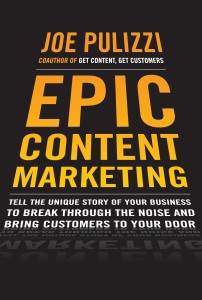 My newest book, Epic Content Marketing, was just released this week. Naturally, the title has prompted many marketers to ask me, “What exactly does epic content marketing entail?”
My newest book, Epic Content Marketing, was just released this week. Naturally, the title has prompted many marketers to ask me, “What exactly does epic content marketing entail?”
To start, take a look at the content you already have. Most likely, your organization has plenty of feature- and benefit-related content, as most brands are quite adept at talking about themselves. We clearly don’t need more of that kind of content, especially when that type of information is only useful for a very small part of a buyer’s journey.
What brands lack are stories that engage their customers — and drive customers and prospects to take a desired action.
The ultimate goal of our content marketing efforts is to “move” the customer in some way.
We need to positively affect them, engage them, and do whatever is necessary to play a useful role in their lives and their conversations. With that, here the six key principles of epic content marketing.
1. Epic content fills a need.
Your content should address some unmet need or answer a question your customers have. It needs to be useful to them in some way — above and beyond what you offer in the way of products and/or services. In some cases, it may fill an emotional need (like Coca-Cola’s content and Red Bull’s storytelling efforts aim to do).
2. It communicates consistently.
The primary hallmark of a successful publisher is consistency, both in terms of quality and delivery. Epic content reliably delivers on the promises your brand makes. Whether you are asking your audience to subscribe to a monthly magazine or daily email newsletter, you must ensure that they receive what they signed up for and that it always arrives on time and as expected. This is where so many companies fall down.
3. It requires you to find your unique, and human, voice.
The benefits of not being a journalistic entity is that you have nothing to hold you back from being… well… you. Find what your voice is and share it. If your company’s story is all about humor, share that. If it’s a bit sarcastic, that’s okay too.
4. It expresses a point of view.
This is not encyclopedia content. You are not giving a history report. Don’t be afraid to take sides on matters that can position you and your company as an expert. Chipotle’s runaway viral hit The Scarecrow clearly has a point of view — that locally sourced and responsibly produced food is, well, superior to how most food is processed today. Don’t be afraid to take stances like this.
5. It is devoid of “sales speak”.
At Content Marketing Institute, when we create a piece of content that is about us vs. an educational post, it only garners 25 percent of the average page views and social shares our content normally drives. The more you talk about yourself, the less people will share and spread your story. It’s that simple.
6. It’s considered to be the best in its class.
Though you might not be able to achieve this at the very beginning, the ultimate goal for your content is to be considered the best in its class. I know it may sound overly simplified, but if you expect your customers to spend time with your content, you must deliver amazing value to them, and nothing less.
Take some time to look at your content marketing strategy. How many of these six principles are you achieving in your content efforts?
As a business, your content marketing goal is to become part of the fabric of your customers’ lives. Once you can do that, selling to them becomes relatively easy. The good news is that we can all be epic — if we follow these six principles. Good luck!
Learn how to execute a winning content marketing program.
Watch Content Marketing Implementation: Executing Winning Content with Joe Pulizzi, and get into the nitty-gritty of what it takes to execute engaging content marketing that turns prospects into buyers. Plus, he shares 42 winning content marketing tactics, and a proven social media publishing plan to make your content take off—fast. Get instant access now.
